‘Why are violence and the sacred so intertwined? Why is death seen as necessary to renew life? ... To us the Aztec universe may appear irrational, terrifying, murderous in its brutality; and yet it is a mirror held up to our humanity which we ignore at our cost. For in the name of other ideals and other gods Western culture has been no less addicted to killing, even in our own century.’
- Michael Wood
This final post will be dedicated to the twin disciplines of the Aztec Warrior Knights. The Eagle Warrior and the Jaguar Warrior!
Eagle warriors and Jaguar warriors were a special class of infantry soldier in the Aztec army. These military orders were made up of the bravest soldiers of noble birth and those who had taken the greatest number of prisoners in battle. Eagle warriors, along with the Jaguar warriors, were the only such societies that did not restrict access solely to the nobility, as commoners "macehuales" were occasionally admitted for special merit.
The Eagles were soldiers of the sun, for the eagle was the symbol of the sun, and of all of the Aztec warriors, they were the most feared. While the jaguar motif was used due to the belief that the jaguar represented Tezcatlipoca, god of the night sky. It is believed that Aztecs also wore these dresses at war because they could call upon the strengths of the associated animals.
To become an Eagle or Jaguar warrior, a member of the Aztec army had to capture at least four enemies during battles. In this way, the Aztecs rewarded those who could bring fresh sacrifices to the temples. This was said to honor the gods in a way far greater than killing enemy soldiers in the battlefield. This made the life of Aztec warriors one of constant battle, as the primary purpose for this continual warfare was to take prisoners, and as the Aztec empire expanded, so too grew the hunger of the temples for sacrifices.
These warriors used a number of weapons; including the atlatl, bows, spears, daggers, and the impressive macuahuitl. Most Aztec weapons were intended to stun and capture opponents rather than to kill them, however this was not the case with the Spanish invaders.
It is sometimes referred to as a sword or club, but it lacks a true European equivalent. It was capable of inflicting serious lacerations from the rows of obsidian blades embedded in its sides. The macuahuitl was 3 to 4 feet long, and roughly three inches broad, with a groove along either edge, into which sharp-edged pieces of flint or obsidian were inserted, and firmly fixed with an adhesive compound. The rows of obsidian blades were sometimes discontinuous, but sometimes the rows were set close together and formed a single edge. The macuahuitl was made with either one-handed or two-handed grips, as well as in rectangular, ovoid, or pointed forms. The two-handed macuahuitl has been described as tall as a man and capable of decapitating a horse.
The atlatl or spear-thrower is a tool that uses leverage to achieve greater velocity in dart throwing. It consists of a shaft with a cup or a spur at the end that supports and propels the butt of the dart. The atlatl is held in one hand, gripped near the end farthest from the cup. The dart is thrown by the action of the upper arm and wrist, using the atlatl as a low mass, fast-moving extension of the throwing arm. This acts as a lever that trades force for speed, and can readily impart to a projectile a speed of over 93 mph.
The uniform of Eagle warriors signified both courage on the battlefield and physical strength. The Aztecs wore a lightweight close-fitting breastplate, which suited the Mesoamerican climate. They carried round shields that were brightly colored and decorated with feathers. A warrior's legs would be protected with leather strips, similar to European greaves. Eagle warriors wore eagle-shaped headdresses that included an open beak, and used eagle feathers as adornments. A jaguar warrior would don the skin of a jaguar and adorn himself with its claws.
In current culture, the eagle warrior is a representation of the Aztec culture, and therefore, the Mexican tradition. Some companies use the eagle warrior as a symbol that denotes strength, aggressiveness, competitiveness, and remembrance of the ancient cultures of Mexico.
References:
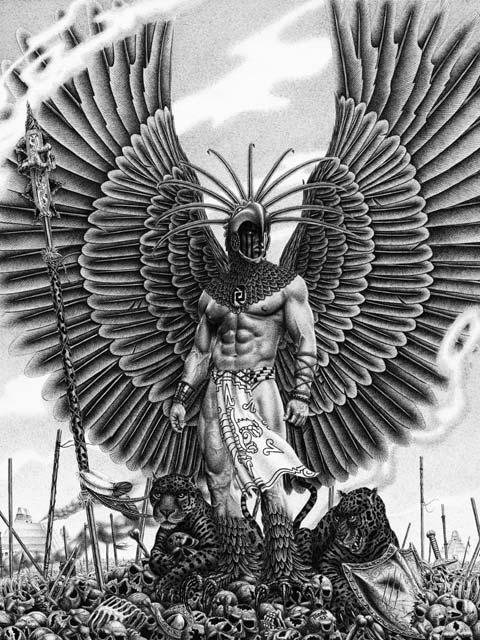
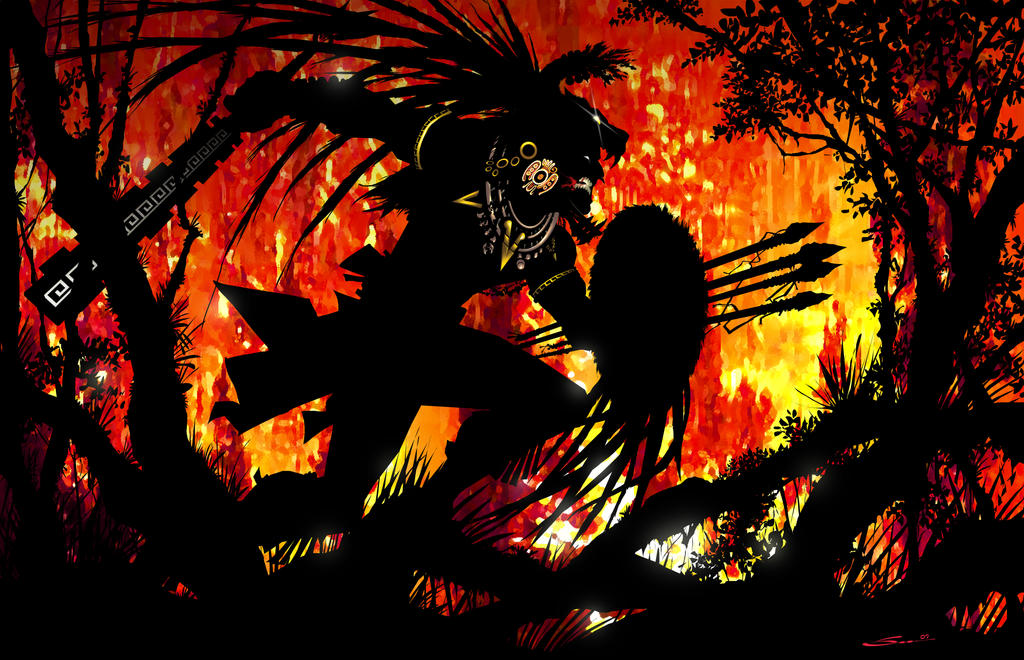
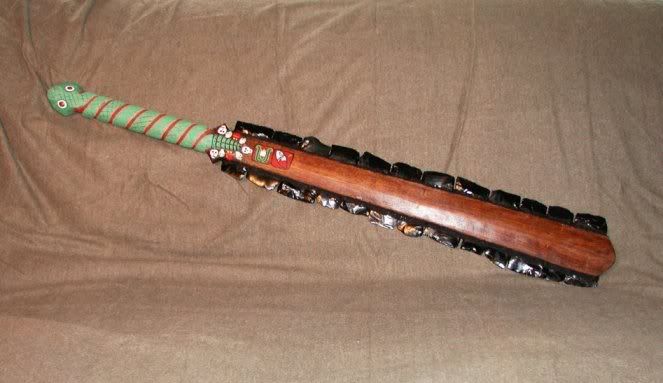
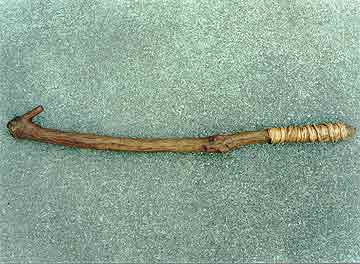
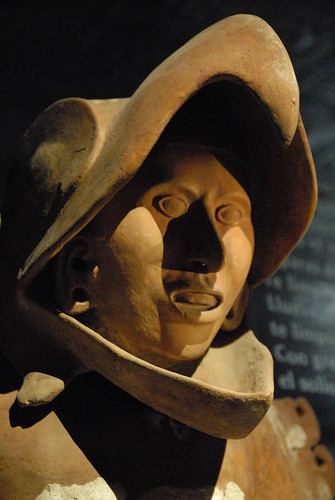
A very fitting end for this blog, not much better can one get than detailing the highest military orders of the Aztecs.
ReplyDeleteMany cultures seemed to have drilled into the conscripts of their military branches the importance of capturing enemy forces rather than annihilating them outright. It is no coincidence that history's greatest warfare tactician, Sun Tzu (or Sun Wu as some prefer), reflects this belief in the first lesson of his third chapter of The Art of War:
"In the practical art of war, the best thing of all is to take the enemy's country whole and intact; to shatter and destroy it is not so good. So, too, is it better to recapture an army entire than to destroy it, to capture a regiment, a detachment or a company entire than to destroy them."
Obliviously the Aztecs did not see eye to eye with Sun Tzu's advice on what to do with prisoners though, as you have clearly illustrated.
Moving on to weapons now, the macuahuitl is indeed a rather curious weapon. I once had the lifetime opportunity to hold one once that belonged to a friend of the family who collected weapons from various cultures. Of course one had to be careful with the obsidian parts of one. I have seen examples of similar weapons within the Pacific island chains.
The atlatl though can be considered the true weapon of the Americas and of the past. It's prevalence throughout the world and its transformation from hunting tool to war implement and then to the form of peace pipes is truly a great saga of weapon history. I would highly recommend viewing some of the military channel programs that have discussed the atlatl, for although sometimes the facts are miscued, the presentations are worth watching.
I do love the Aztecs and have learned something new about them thanks to this post. The fact that they had a eagle and jaguar class of warrior is interesting. They certainly put emphasis on the jaguar in their culture. The fact that the Eagle Warriors had to capture 4 people in battle and that is how they got their sacrifice victims sometimes is new to me. I wish I would have know this when I was doing my blog post on them! Its such a great tidbit of information.
ReplyDeleteThe weapons of the Aztecs seem so primitive but they are so deadly regardless. I like the photos and thorough explanations given with each one. It really helps you to visualize the warriors wielding those weapons. I enjoyed your post quite thoroughly. Thanks!
https://imagizer.imageshack.us/v2/1043x514q90/674/7fz1bH.jpg This is a Maqauhuitl replic of that iconic weapon from Aztec Empire.
ReplyDelete